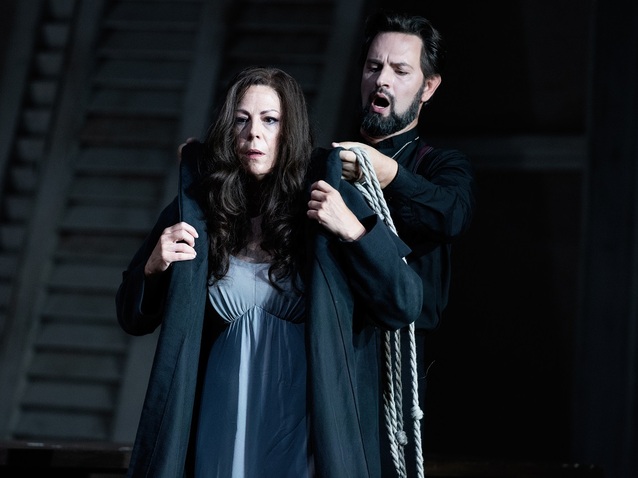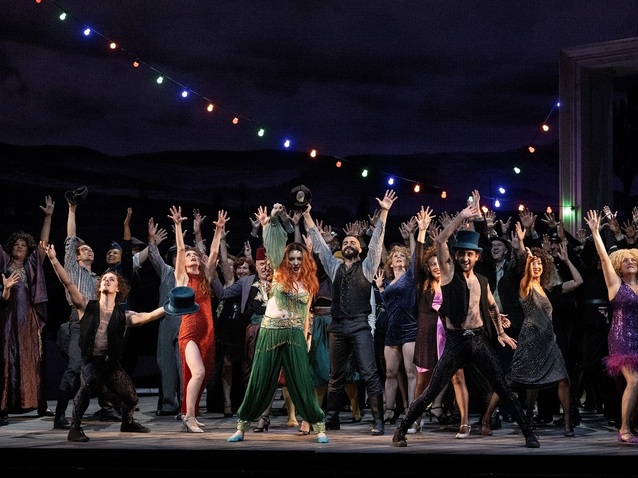 © Camilla Greenwell
© Camilla Greenwell
Set in eighteenth century Spain, Giuseppe Verdi’s La forza del destino sees the Marquis of Calatrava oppose his daughter Leonora’s desired union with her South American lover Don Alvaro, believing he is not good enough for her. When, however, Don Alvaro surrenders himself to prove that he never violated her, he throws down his pistol and accidentally kills the Marquis when it goes off. Leonora’s brother Don Carlo sets out to avenge his father’s death but he and Don Alvaro end up fighting side by side in battle in Italy, and even saving each others’ lives. When each subsequently discovers who the other is, however, tragedy ensues and both Don Carlo and Leonora end up dead.
The opera, which is based on Ángel de Saavedra’s drama Don Álvaro o la fuerza del sino of 1835 and has a libretto by Francesco Maria Piave, originally premiered in St Petersburg in 1862. However, the version that is almost always performed today, with an Overture that has been used in everything from the film Jean de Florette to Stella Artois adverts, began life in Milan in 1869, with Antonio Ghislanzoni having contributed to the libretto. Destiny is obviously a key component of the piece, but even this concept takes on a series of guises. After Don Alvaro kills the Marquis, Don Carlo disguises himself to hunt Alvaro (and indeed Leonora) down, with his unremitting approach to his task making him believe that Alvaro is destined to die at his hands. The way in which Carlo and Alvaro’s lives subsequently become intertwined also make things seem preordained. However, the fact there are numerous occasions when we feel that events could have unfolded differently suggest, on the one hand, that things did not have to be like this, and that, on the other, they were destined to since, of all of the outcomes that were possible, this is the one that transpired. Right to the end, Alvaro seeks some form of reconciliation with Carlo, but Carlo is too determined to fulfil his destiny and dispatch Alvaro. However, since it is Carlo and Leonora who end up dead, it seems that Alvaro, no matter how inadvertently or unwillingly, was destined to destroy the Calatrava family, even though in another sense they clearly ruined themselves.

Evgeny Stavinsky (Padre Guardiano), Sondra Radvanovsky (Donna Leonora), ROH La Forza del Destino 2023 © Camilla Greenwell
Christof Loy’s production, which premiered at the Royal Opera House in 2019 having first appeared for Dutch National Opera in 2017, emphasises how destiny hangs over the House of Calatrava by literally setting the entire action in the house of Calatrava! The Overture reveals Leonora and Don Carlo growing up there, and it is telling just how often they are left alone by their father, whose cold and distant manner may be a response to losing his own wife. The games they play as children say much about their pious upbringing and own convictions, and it is also shown how Leonora had a second brother who died in childhood. This suggests there is room in Leonora’s heart for her to love her brother Carlo and another man, only her family cannot see this. Towards the end of the Overture, Carlo departs to become a soldier, with his father saying his goodbye with a formal handshake, rather than the warmth that Carlo has presumably always craved.
In Act I Leonora and Alvaro attempt unsuccessfully to escape through a window, and until this point Christian Schmidt’s set, in depicting the Calatrava house, has shown the literal setting for the action. However, Act II, the second scene of which takes place at a monastery, sees the house remain, only one of the walls has now been replaced by a chancel. This suggests that if there is a way of escaping fate it is through the church, but that it is hardly a certain route. Act III takes place away at war in Italy, but while the stage is far more open at this point, the floor is still that of the original Calatrava house. Then the very final scene, which takes place near Leonora’s hermitage, restores the house to its original state, with all of the walls having returned.
This overarching premise is complemented by some very interesting details. For example, when the monastery’s abbot, Padre Guardiano, comes out to meet Leonora in Act II, she slips behind a wardrobe in the room, suggesting how she used to hide from her father as a child. Then in Act IV this wardrobe represents the hermitage to which she has retreated. Throughout the production Loy emphasises how Leonora’s relationship with her father has affected her perception of any seemingly patriarchal figure. For example, during the initial killing of the Marquis, huge images of the protagonists in the event are projected onto the walls of the house, thus magnifying the moment from which practically everything else in the opera spawns. These appear twice more during the production, and the first time is during her encounter with the father figure of Padre Guardiano, as if his very presence is enough to trigger her worst memories.

La forza del destino ROH 2023 © Camilla Greenwell
Interestingly, four years ago the recurrent use of these images felt like overkill, but this time around their repetition feels justified and effective. However, Act III does suffer from the same problems as before in simply being too cliché ridden. Prostitutes and chairs both feel like stereotypical directorial devices, and Loy manages to fill the stage with both. It is hard to criticise the achievement of choreographer Otto Pichler in the routine he has created for ‘Rataplan, rataplan, della gloria’ that ends Act III, and which involves the entire cast. However, the section does feel a little incongruent with what has preceded it, even allowing for the fact that its whole point is to provide variation and some light relief.
Musically, the evening is extremely strong. Sir Mark Elder’s conducting is superlative as he moves everything forward at a pace that captures the overall sweep of the music, while also allowing all of the relevant colours, textures and details to come to the fore. Sondra Radvanovsky is outstanding as Leonora, with her top lines being thrilling precisely because they feel as secure as they are overwhelming. Brian Jagde reveals a brilliantly expansive and unflagging tenor as Don Alvaro, and his voice works very well with the strong yet nuanced baritone of Étienne Dupuis’s Don Carlo (Aleksei Isaev plays the latter part on 27 September). Evgeny Stavinsky is a tremendous Padre Guardiano as he asserts his deep and firm bass to excellent effect, while Rodion Pogossov elicits much comedy value from the role of Fra Melitone. Carlo Bosi similarly puts everything into his portrayal of Mastro Trabuco, while Vasilisa Berzhanskaya reveals an intriguing mezzo-soprano and some notably accomplished dance steps as the fortune teller Preziosilla. Finally, James Creswell gives such an accomplished performance in the small role of the Marquis of Calatrava that it would be good to hear a lot more of him at the Royal Opera House.
By Sam Smith
La forza del destino | 19 September – 9 October 2023 | Royal Opera House, Covent Garden
the 21 of September, 2023 | Print
Comments